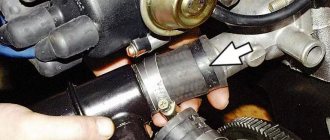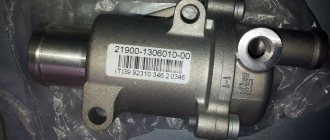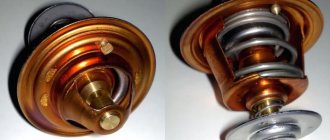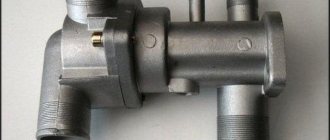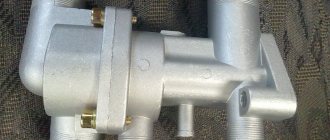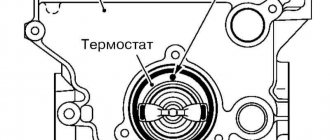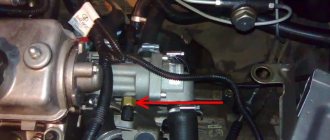If the car engine overheats or the antifreeze temperature does not reach operating temperature, the thermostat may be a possible cause of these malfunctions. There is no difference when replacing the thermostat on Lada cars (Granta, Kalina, Priora, Vesta, Largus, Niva or XRAY) with 8 and 16 valve engines, all actions are performed in the same way.
You will need : drain the coolant, prepare a flathead screwdriver, a Phillips screwdriver, a set of wrenches and silicone sealant.
Procedure:
- Remove the engine air filter housing by disconnecting the hose and the connector with the MAF wires.
- Loosen all thermostat hose clamps (their number may vary depending on the thermostat model).
- Remove the thermostat assembly by unscrewing the two screws securing it and removing the ground connector and the connector with wires from the temperature sensor.
The thermostat is installed in the reverse order, after first cleaning the seat from dirt and applying sealant. The whole process is also shown in the video:
Let us remind you that it is better to check it before installing the thermostat. If this is not the problem, check the cooling system according to the diagram.
As you know, modern cars use a special liquid to cool the power plant. The versatility of this option allows you to simultaneously provide interior heating in winter.
In order for this system to work properly, a special device called a thermostat is also installed in it. In another way, it is also called a coolant temperature regulator. One of its functions is to help the engine warm up as quickly as possible and maintain it in the required condition.
In this article we will talk about how the thermostat of a Grant car is converted to a higher response threshold (92 degrees). In addition, we will tell you about the principle of operation of this device and about possible problems that arise in it.
How does it work
Specifically in Grant, the thermostat is located between the power plant and the radiator. The main task of the unit in question is to prevent the circulation of antifreeze until the engine warms up to the required temperature. If the engine remains cold, the coolant does not move.
Ideally, the thermostat operates after the temperature of the power plant reaches 80-95 degrees. All this allows, among other things, to reduce the volume of emissions harmful to the environment and minimize engine wear.
By the way, checking the functionality of the thermostat is relatively easy. It must be placed in a container with boiling water. If the element is working properly, its valve will open approximately 20 millimeters.
Standard location of the thermoelement on the Lada Grant
In cars of the Lada Granta family, a thermoelement is installed inside the body of the flow regulator. The latter is fixed at the end of the engine compartment cylinder block on the right side.
Schematically, the mechanism is located between the radiator and the wall of the cylinder block.
Unlike previous Lada models, in Grant the liquid flows directly into the regulator, and not into the intermediate compartment.
The standard thermoelement is activated when the antifreeze reaches a temperature of 90°C. Such data is indicated in the operating instructions. The actual range is lower, from 78 – 79°C.
Dismantled spare parts
Deviations are not significant, but they have “side effects”:
- increased fuel consumption;
- combustion of the fuel mixture is not complete;
- excessive formation of soot due to incomplete combustion of fuel;
- obvious exhaust from the car's tailpipe.
Common faults
Despite the relative simplicity of the device, troubles sometimes occur with it. A malfunctioning thermostat will most likely render the vehicle unable to be driven. More often, its incorrect operation is provoked by the following reasons:
- unstable functioning of the motor (when tripling, the valve is often damaged);
- antifreeze getting inside the device;
- wax flows out;
- mechanical damage to the valve;
- deterioration of the rubber gasket;
However, there is usually one main reason - corrosion.
If for some reason the valve does not open at all, the coolant does not circulate and the power plant overheats. Moreover, the problem will arise regardless of how cold it is outside and how quickly the car accelerates.
Incomplete opening of the valve also causes overheating. True, in this case it will not be critical if external factors do not contribute to this. A delay in closing leads to a prolonged warm-up of the engine, and in winter it most likely will not be able to reach operating temperature.
Major breakdowns
Although the thermostat is small in size, its importance for the “health” of the Lada Granta engine is enormous. Among the most common reasons leading to the inevitable failure of the thermostat is corrosion.
This circumstance can lead to the movable element getting stuck in a certain position. If this happens when the valve is closed, then there is a likely risk of engine overheating (you need to monitor the temperature indicator on the device). In this case, the thermostat will need to be replaced.
When the moving component of the thermostat deigns to get stuck in the open position, the motor will take a very long time to reach the operating temperature setting or will not warm up at all, which is likely in winter.
If all components of the cooling circuit are in working order, then at zero outside temperature the Lada Granta engine warms up in 10 minutes. If the valve does not “agree” to close, then even in the summer heat the engine will not be able to warm up above the 70-degree limit.
In all of these cases, the thermostat needs to be replaced.
Now let's look at a method for checking the functionality of the thermostat.
Replacing the front wheel bearing of Lada Granta
Revision option
As evidenced by reviews from grant owners, the manufacturer supplies this model with a rather weak thermostat. Usually it opens access to antifreeze after the engine warms up to 80 radii. This is due to low-quality wax inserts, which we described above.
In most cases, such a problem is not perceived as something serious, since it does not harm the operation of the engine in any way. The only drawback is that in winter, when there is frost, the interior can be cool. The situation becomes more complicated if the owner of the car switches to gas.
In this case, it makes sense to modify the thermostat so that it opens at 92 degrees. To do this you will need to purchase a new one. The entire element does not need to be replaced, so only the insert is taken out of the purchased one.
Experts advise choosing the model – VERNET TH4898.92D. Its cost is low - approximately 400 rubles.
The step-by-step replacement procedure is as follows:
- first of all, the car is driven onto a ramp or pit;
- drain antifreeze from the cooling system;
- remove the air duct because it is in the way;
- the thermostat itself is dismantled (but you can leave it in place and only remove the cover from it, the main thing is not to lose the seal);
- the old thermocouple is removed and a new one is inserted;
- they press it with the original spring and limiter.
On average, the response temperature after such a procedure increases by 15 percent.
The whole process is recorded in this video:
All cars whose engines are cooled by a special liquid have at their disposal a device called a thermostat. Lada Granta is no exception.
In the Grant model, the thermostat is located between the radiator and the engine. In the article we will talk about the concept of a car thermostat, what components it consists of and how it functions, and also consider the main types of thermostat malfunctions.
The thermostat is called the antifreeze (antifreeze) temperature regulator in the engine cooling system. It increases the engine warm-up rate and maintains the required thermal state.
The key job of the thermostat is to hold back the flow of radiator fluid until the engine has warmed up. If the engine remains cold, the coolant does not pass through it to the radiator.
The thermostat opens when the engine temperature reaches 95 degrees. Thanks to its operation, the engine warms up faster. Thus, in the Lada Granta, the thermostat reduces the amount of harmful emissions and reduces engine wear to a minimum.
If desired, you can clearly see the operation of the thermostat at home. Place the thermostat in a container filled with water, then place it on the electric stove. As the moment of boiling water approaches, the thermostat valve will open approximately 2 cm. It is recommended to experiment with a new thermostat without removing yours from your own car.
Features of the LADA Granta cooling system
As in previous LADA models, upon reaching a certain temperature, the thermostat switches the coolant flow from a small to a large circuit. The small circuit includes:
- cylinder water jacket;
- water pump;
- interior heater.
The difference is that the heater radiator is connected to a small circuit in series and not in parallel. This forces all the coolant to pass through it, improving the heating of the cabin. The thermostat opening temperature is 85 degrees. Upon reaching this mark, the valve opens and the liquid begins to circulate through a large circuit into which. In addition to the small circuit elements, a cooling radiator is included. The advantage of the modernized cooling system is that antifreeze from the engine jacket falls directly onto the thermostat thermocouple without mixing in its housing. This allows the element to respond to the actual engine temperature, opening on time and preventing overheating. The manufacturer has set the permissible thermostat opening range to 85–7 degrees. That is, it can open at both 78 and 93 degrees. According to the official letter from the manufacturer, sent to dealers, the operating temperature of the Grant engine may be 10 degrees lower than that of previous VAZ models. This does not mean that the engine is “underheated” and does not lead to an increase in fuel consumption, deterioration of lubrication and a decrease in engine life. However, owners of the LADA Grant often change the thermostat to a new one, with an opening temperature closer to 90 degrees, or modify the standard thermostat by changing the thermal element.
Thermostat structure and operating conditions
The thermostat contains metals such as copper and brass alloy. The essence of the device's operation lies in a small cylinder turned towards the engine.
In the middle of the cylinder there is a synthetic wax ball, which at a certain temperature (82 degrees Celsius) begins to melt (the wax expands significantly under the influence of heat, changing its solid state to a liquid).
A special pin is pressed into the wax cylinder and is connected to a valve. When the wax melts, as a result of expansion, it begins to squeeze the pin out of the cylinder, while opening the valve through which coolant flows. When the engine stops and cools, the wax in the thermostat hardens and returns to its solid state.
Duration of operation of the thermoelement on the Lada Grant
The explicit resource is not indicated even in the manual, but in practice the interval is 80 - 85 thousand km. Provided that the equipment is regularly maintained and refilled with high-quality antifreeze, the replacement interval can be extended by several thousand kilometers.
Disassembled
Characteristic signs of thermoelement failure on the Lada Grant
- for a long time after the engine warms up, the rubber pipes of the large circle remain cold;
- the circulation of antifreeze is wavy, which indicates obstacles in the path of the liquid, the valve is not fully open;
- depressurization of the structure, liquid leakage;
- mechanical damage from outside.
How to tell if the thermostat is working correctly
In order to find out whether the thermostat is working or not, it is necessary to warm up the engine so that the arrow indicating the temperature does not reach the red mark of the indicator quite a bit.
After that, turn off the engine, go to the hood and open it, look for the upper radiator hose. This rubber hose is usually black in color and is approximately 5cm in diameter.
There are metal clamps at its ends. The upper hose is attached to the top of the radiator. Then we look for the lower hose. It looks like the top one, only it is attached to the bottom of the radiator.
Touch the hoses carefully; they may be hot enough to burn you. If the engine temperature indicator shows that the engine is hot, but one of the hoses is cold, then most likely the thermostat valve is closed and is not allowing coolant through the radiator.
In this case, replace the old thermostat with a new one as quickly as possible (after waiting until the engine has cooled down).
There is another “folk” method for checking the functionality of the thermostat and it is as follows. Place the thermostat in a vessel with boiled (temperature should be about 100 degrees) water.
Next, we visually observe whether the thermostat valve opens. If it opens, it means it’s working. If not, we replace the damaged one with a new one. The above method involves removing the thermostat from the car.
If the thermostat malfunctions in a car, overheating or, more often, low engine temperature is observed. Such phenomena are associated with the thermostat jamming in one position; as a result, the coolant moves in one circle (large or small). Lack of adjustment of coolant distribution leads to deviations from the engine temperature regime. Thermostat failure is one of the most common problems in a cooling system. To replace the thermostat on a Lada Granta car, the coolant from the cooling system does not need to be completely drained.
You will need: TORX TZO wrench, 13mm socket, Phillips-blade screwdriver.
Lada 2112 › Logbook › Modification of the grant thermostat
Let me start with the fact that a year ago I installed a thermostat from a grant from BEHR. For a long time I was looking for a thermostat from this particular company in my city and in the end it was found. After installing it, the car began to warm up faster and the heater began to heat a little better, which is exactly what I wanted. After driving with it during the winter, I noticed that with it the car keeps the temperature while driving at 77-79, which is very low for the proper operation of our engine. In the heat of the summer, even in the longest traffic jams, the car was reluctant to warm up, which definitely made me happy, but in the end I decided to replace the thermocouple with a 92-degree thermocouple. The Wahler 3091.92D thermocouple fits into the BEHR housing without modifications. The search for this element in my city was unsuccessful... Either the price was higher than the price of the thermostat assembly, or the waiting period was more than a month. If I'm not mistaken, I was one of the first to install the BUBLS-64 grant thermostat. After recording about the installation, everyone pestered him with questions: what? How? and why?))) It was from him that I came across an idea for improvement for people like me who couldn’t find a thermocouple from Wahler that fits without much modification. This thermoelement was Wahler 3017.92D50. Again, it was not available anywhere and I was offered a Wahler 3017.92D2 instead. They differ only in the presence or absence of a gasket. To implement it, you need to grind a new plate, because... the native one is 1 mm smaller and the consequence does not completely cover the small circle and does not maintain a normal temperature. This element was purchased for 550 rubles and given to my father to make a plate for it. Let me tell you right away that the photos are not mine, because... I did it a month ago and didn’t even think about registering for a drive, so I didn’t take any pictures)) Here is a link to his used one. Modification of the Grant 2190 thermostat or even warmer.
Thermoelement and plate for it
After the modification, the stove began to fry and the consumption dropped by about 1.5 liters. With this element, the temperature on the go stays at 88-90 degrees. If anyone is interested in what and how, ask questions)
Removing the thermostat Lada Granta
The thermostats of the 8-valve engines and the 16-valve Lada Granta engine are located differently, and therefore their replacement for these engines is shown separately. To remove the thermostat of the VAZ-11183, VAZ-21116 and VAZ-11186 engines, do the following: 1. Remove the plug from the expansion tank. Unscrew the drain plug at the bottom of the right radiator tank. Drain the coolant that comes out of the engine radiator into a container. Screw the drain plug back in.2. Release the clamp on the coolant temperature sensor wiring harness. 3. ...and disconnect the block from the sensor
4. Loosen the clamp securing the rear hose to the thermostat cover...
5. ...and remove the hose from the cover fitting
6. Similarly, disconnect the front hose from the thermostat housing pipe.
7. Unscrew the nut securing the ground wire to the upper stud securing the thermostat housing...
8. ...and remove the nut, washer and wire end from the stud.
Removing and checking the thermostat
If the thermostat is working properly, after starting a cold engine, the lower hose leading from the radiator should remain cold for some time, and then (after the coolant temperature exceeds 85 ± 2 °C) quickly heat up, which indicates the start of coolant circulation in a large circle. To dismantle the thermostat, remove the air supply hose to the throttle assembly (see “Removing the air supply hose to the throttle assembly”) and the air filter (see “Removing the air filter and air intake”). Drain the liquid from the cooling system (see “Replacing the coolant”).
Having released the clamp of the engine control system wiring harness block, disconnect the block from the coolant temperature sensor connector. Using a 13 mm wrench, unscrew the nut securing the tip of the “mass” wire to the thermostat housing...
...remove the wire end from the stud.
Using the “8” head, loosen the tightening of the clamp securing the radiator supply hose...
...and remove the hose from the thermostat housing pipe.
Similarly, disconnect the fluid supply hose to the heater radiator from the thermostat cover pipe.
Using a 13mm socket, unscrew the two nuts securing the thermostat housing and remove the housing from the cylinder head studs.
The connection between the thermostat housing and the cylinder head is sealed with a gasket.
Using a Torx T‑30 wrench, unscrew the three screws securing the thermostat cover (shown with the coolant temperature sensor removed).…
...and remove the cover.
The connection between the cover and the thermostat body is sealed with a rubber ring.
Overcoming the force of the spring, we press the jaws of the pliers onto the fixing plate.
By turning the plate in any direction, we disengage it from the protrusions of the thermostat housing.
...and the thermostat spring.
We take out the thermostat bottle. To check the thermostat, lower its container into a transparent container with coolant. We heat the vessel, simultaneously stirring the liquid and monitoring the beginning of movement of the cylinder rod with a thermometer. For a working thermostat, the cylinder rod should begin to extend at a temperature of 85±2 °C. At a liquid temperature of 100±2 °C, the cylinder rod must extend completely - the rod stroke is at least 8 mm. We assemble and install the thermostat in the reverse order. When installing the cylinder, its rod must enter...
...into the housing hole. We replace the sealing ring of the thermostat cover and the gasket at the connection of the housing with the cylinder head with new ones. Before installation, we clean the mating surfaces of the cylinder head from remnants of the old gasket...
Thermostats
Brand name – LT – LuzarThermostat
Thermostats are necessary to direct the flow of coolant in the cooling system of automobile engines, thereby regulating the temperature of the coolant.
- when the temperature rises (usually at ≈80ºC), the main thermostat valve opens while the bypass valve closes;
- the radiator is included in the cooling circuit;
- the coolant temperature drops;
- When the temperature decreases, the reverse process occurs.
When choosing a thermostat, it should be remembered that two different vector requirements for the operation of the cooling system will depend on the indicated indicators - on the one hand, rapid warming up of the engine (and, therefore, a comfortable temperature in the car interior) and, on the other hand, the moment of “connection” to cooling radiator circuit (“large cooling circle”) to avoid engine overheating. It is the thermostat that solves the most important and controversial problem - to achieve the optimal engine temperature, while ensuring the absence of overheating, the flow of hot liquid into the heating radiator and comfort in the cabin, smoothing out the effect of “thermal shock”.
Design of LUZAR thermostats
An automobile thermostat consists of a temperature sensor, which is a brass cylinder with a filler (technical paraffin or thermal wax), which expands when heated, with a rod on which spring-loaded plates of the main and bypass valves are placed; the temperature sensor is rigidly fixed to the frame, through which the thermoelement can be installed in the thermostat housing. The valve discs have rubber seals.
Design image
- modern automotive industry, with the increasing complexity of automobile engines, is switching to the use of electronic thermostats, where temperature control is carried out by sensors, and the thermostat valves are controlled by micromotors (LUZAR does not produce electronic thermostats)
- Many modern engines have not one, but two or more thermostats - for non-uniform temperature control in different parts of the engine.
What to look for when choosing
Automotive thermostats can be cased or uncased, depending on the design laid down by the designer of the engine. LUZAR produces thermostats for domestic cars, foreign cars and commercial vehicles. To select a spare part for your car, indicate its make and model: the search filter will return all suitable products.
Step-by-step instructions for replacing the thermoelement on a Lada Grant
Required materials and tools:
- sockets, ratchet, screwdriver with bits;
- 0 liters of new antifreeze, watering can;
- pliers;
- container for draining waste;
- rags;
- sealant;
- spring, metal retaining ring, thermoelement.
Complete set
Sequencing
There are two ways to replace the thermocouple:
- with dismantling the regulator;
- without removing the thermostat.
Using the Lada Granta car as an example, we will consider both options.
Owner reviews
| № | Positive |
| 1. | Gennady: 65,000 km, no comments on the cooling system elements. For my part, I try to systematically carry out technical inspections and fill in high-quality antifreeze. |
| 2. | Vladimir: at 75,000 km I replaced the “regulator” for the first time, I think that for a domestic car the service life is more than good. |
| 3. | Alexander: During the two years of operation of the machine, breakdowns occurred, but there were no large-scale ones. I eliminated the unimportant ones on my own. Of course, “our” manufacturer is far from perfect, but the quality is an order of magnitude higher than previous modifications. |
| 4. | Sergey: The stove heater in Grant heats very well, it’s hot, I often open the windows for ventilation. I don't remember early models having this quality. |
| 5. | Vasily: I’m pleased with the build quality of the domestic car; there are some faults, but they can be easily fixed on your own. |
| 6. | Gennady: after buying the car, I immediately drained the “native” antifreeze and filled it with high-quality imported one. The cooling system works like a clock. |
| 7. | Dmitry: I’m happy with the car, the units are working as normal. I follow the maintenance schedule and buy original parts. |
| Negative | |
| 1. | Kirill: I drove 35,000 km without any breakdowns, and then the car started to fall apart. In a year and a half, I have already visited a service station twice unscheduled for diagnostics. |
| 2. | Stepan: I regretted that I bought Grant, the model is crude, there are many flaws and defects. The manufacturer is in no hurry to fix it. |
| 3. | Victor: don’t rush to buy Grant; Renault Logan can be used as a good alternative. |
Properly assembled thermocouple
Conclusion
As standard, the Lada Granta is equipped with parts from a domestic manufacturer. The average service life of heating system elements is 75 – 80 thousand km.
As an alternative to domestic elements (21082), owners purchase foreign analogues, such as Wahler, Stellox. The service life is 10–15% longer, but the price is an order of magnitude higher. It's worth thinking a few times before buying.
Many cars with a classic internal combustion engine have a cooling system with a very interesting part called a thermostat. The popular Russian model of the budget segment Lada Granta is not included in the number of exceptions. In this car, the thermostat is conveniently located between the engine itself and the radiator assembly. In our material we will try to shed light on the design features of the thermostat and determine the main list of possible malfunctions.
The thermostat is a special temperature regulator for the antifreeze circulating in the cooling system. With the help of this part, the engine warms up quickly, after which it participates in the “group” of system components designed to maintain the temperature factor at a certain level. Sometimes the thermostat needs to be replaced.
The main purpose of the element considered here is to ensure the circulation of refrigerant:
- in a small circle until the engine reaches operating temperature;
- after the unit warms up, the liquid begins its circulation in the so-called large circle, when it has to pass through the radiator.
This redirection is ensured by an internal valve present in the thermostat itself, which changes its position depending on the temperature of the refrigerant in the circuit. The valve opening process is observed when the liquid temperature reaches 95 degrees Celsius. As an indirect function of the thermostat, one can consider its contribution to optimizing exhaust and minimizing wear of the LADA Granta engine.
For greater clarity, the functionality of this element can be considered in everyday conditions. To do this, you will need to place our “hero” in a container previously filled with water. Now we heat it on the stove and watch with lust the approaching moment of boiling of the liquid. As it heats up, the thermostat valve will open approximately 20 mm. Such experiments should be carried out with a new product in order to ensure its functionality before installation on the car.
Method No. 1
- We install the car within the perimeter of the repair area and secure the wheels with wheel chocks for safety purposes.
- We unscrew the plug from the expansion tank and remove the resulting vacuum.
- We loosen the clamps - ties on the distributor, pour 2.5 - 3.0 liters into a plastic container.
- Disconnect the pipes from the fittings.
Disconnecting pipes
- We unscrew the temperature sensor from the end, disconnect the ground terminal, and unscrew the two studs. Remove the antifreeze flow regulator.
- We place the product in a vice, unscrew the two screws of the cover, and remove it.
- Use pliers to press the metal spring, press it down, and remove the plate.
- After complete dismantling has been completed, we wipe the cavity of the part and carry out troubleshooting of the body.
- We install new components, replace the Lada Granta thermostat insert, and reassemble the structure.
How to increase the opening temperature of the thermostat
For the mood :) it is not prohibited.
Winter has come. The cold has come. It got cold in the car...
I didn’t like the whole thing, and I decided to redo the thermostat a little. How I did it and what happened in the end - watch this video:
when I saw the photo of the post... the temperature... began to rise)) now I understand! How does he work! …(although I didn’t know that some people call it a thermostat…)))))
I just bought myself at 87 degrees and set it and forgot about it
why does the author deny the existence of calipers?
You can also install a climate control unit from Volvo - the automatic mode will maintain any temperature absolutely independently. I’m driving for the second season, I’m having a blast and I barely understand how I used to drive with factory cables. )))
In the engine, slightly different processes occur than in the pan. I modified my thermostat this way, the length of the rod is 31mm. The opening is 94, and it stays somewhere around 86-88.
It’s a shame to climb on such a lady with a short pin =)))
It's strange that I didn't use a thermos. And the current heats up to 87 degrees, and I bought boiling water in the cabin for the second year, I think sometimes the motor boils, but there’s nothing like that.
But the experiment with the additional pump was a great success; it’s noticeably hot as it connects it) I start the car and immediately turn on the additional pump and the oven at first speed for three minutes and I can already feel the warmth about a hundred meters. I drive to the main road from the house and turn it up to full. Well, I threw the spring bushing in a small circle to check.
KEEP THE TEMPERATURE!
The thermostat is a simple device. But very important. Errors when replacing it are unacceptable.
The thermostat in the engine is used to maintain the proper temperature in the cooling system. But its functions are not limited to this: power, fuel consumption, exhaust emissions, and the efficiency of the heater all depend on a simple device. And also durability, engine life.
On all VAZ cars, the thermostat is removed from the engine block head and is an independent element. Today we know the following models:
2101 - all VAZ “classics” are equipped with these, starting with the first-born VAZ 2101. The valve begins to open at a temperature of 80±2°, and is fully open at 95±2°. A distinctive feature of the “first” thermostat is that the pipes are rotated relative to each other at an angle of slightly more than 90 degrees (photo 1 on the left).
2121 - for Niva. In terms of filling, the thermostat is practically “zero first”. Only due to the layout features, its pipes are located on the body at an angle of almost 180 degrees. By the way, the modernized Niva VAZ 21213 has a thermostat 2101.
2108 - the next generation of thermostats (photo 1 in the center) - intended for Samara engines. The latter have a more advanced combustion chamber shape and a higher compression ratio; their temperature regime is 7° higher than the classic ones. This improves the power and economic characteristics of the machine.
The “eight” thermostat begins to open at 87°, and is fully open at 102°. True, today on the market there are “eighth” thermostats with a valve opening temperature of 85°. It’s easy to explain: the quality of thermostats today is not up to par; the valve often opens with a delay, creating a risk of engine overheating.
So they dropped two degrees. "in reserve."
Thermostat 2108 pipes are located almost like at “zero first”, but seem to be mirrored in relation to it. In addition, closer to the bottom, the “eighth” has an additional thin pipe for connection to the expansion tank (see photo 1 in the center). This is the path for air bubbles to exit the cooling system if they somehow get there.
How to check the operation of a lambda probe video
2110 - structurally repeats the “eight”, it has almost the same characteristics (circulation in the “large circle” will begin at 87 or 85°). Externally, it is even more similar (but also a mirror image, do not confuse it!) with “zero first”, since it does not have an additional thin pipe (photo 1, right).
On the VAZ 2110, the “road” for air was paved from the tee adjacent to the thermostat. The latter is intended for cars with carburetor engines (VAZ 2110 and 21111). If necessary, you can also install a “figure eight” thermostat on them, you just need to thoroughly plug its air pipe.
It happens that manufacturers of these products arbitrarily simplify the design, so when buying a thermostat, look into it.
At the top of the housing there should be a vertical strip of metal or plastic, resembling a curtain, which covers the additional valve in a sector of approximately 270° (photo 2).
Without this curtain, the liquid mixes less well, heats the thermoelectric element less and more slowly - and the thermostat switches to the “large circle” with a delay at elevated temperatures.
2112 - next generation thermostat - for injection engines (photo 3). It differs from the previous ones in that, in addition to the main function, it also increases the efficiency of the heater.
For this purpose, the resistance of the “small circle” was increased, thereby forcing the coolant to flow more intensively through the heater radiator. This thermostat has a throttle hole in the inlet pipe.
The transition from “small” to “large circle” begins at a temperature of 85°. By the way, the temperature threshold for the start of operation of any thermostat is squeezed out on the bottom (photo 4).
Let's now move on to the sensor (photo 5) for turning on the electric fan of the cooling system. Today, two generations of sensors are produced - two-amp and twenty-amp. Moreover, each, in turn, is divided into two categories - for classics and for front-wheel drive models.
The first generation includes veteran sensors TM-108. Since they could not directly switch large currents, this role was assigned to a special power relay, triggered by a command from the sensor.
For classics, this sensor had an index of 2103–3808800. Let's remember: the “treshka” was the first VAZ car without a constantly rotating mechanical impeller. Fan switch-on temperature is 92°, switch-off temperature is 87°.
As already noted, the Samara engine has a more severe temperature regime. Therefore, here the electric fan turns on at a higher temperature than the classic one. The sensor contacts (2108–3828010) close at 99° and open at 94°.
New generation sensors do not need the help of a power relay - they are able to switch current up to 20 A themselves. Their response temperatures remain the same, and the indexes are 661.
3710 (for classics, catalog number 2110-3828010-10) and 66.3710 (for Samara and Ten with engines 21083, number 2110–3828010).
At the same time, on all models “ten”, “Samar” and “Lada” the use of a new fuse block is provided - a European type.
They can be distinguished by the numbers stamped on the edges of the hex key. On new generation sensors the first digits of the marking are stamped: “661” (for classics) or “66” (for “samara” and “ten”), on old ones - TM-108. In any option, the response temperature must be indicated on the adjacent plane.
New sensors can be painlessly installed in place of old ones. On the contrary - under no circumstances! The “one hundred and eighth” contacts will simply burn out if they cannot withstand the high current. In a hypothetical situation - the sensor has failed, and only TM-108 is at hand - you will have to change the electric fan switching circuit by introducing a power relay into it.
As for injection engines (VAZ 2111 and VAZ 2112), their electric cooling system fan is controlled by a controller (“injection brains”). The latter measures the coolant temperature with one of its special sensors. Therefore, in the radiators of the cooling systems of these machines there is no sensor for turning on the electric fan.
A set of retaining ring removers is a matter of technology
PS When the number was being typed up, we were informed that changes were being made to the design of thermostat 2112. The inlet pipe will now have not one throttle hole in the center, but four, arranged in a cross, closer to the walls. In this case, when the valve is open, the liquid washes the thermal power element more reliably.
Thermostats of VAZ cars: 2101 - on the left, 2108 - in the center, 2110 - on the right.
A plastic curtain is visible in the area of the bypass (additional) valve.
Thermostat 2112. This is what the “small circle” throttle hole looks like.
The temperature at which the thermostat begins to operate is indicated on the bottom of the thermostat.
Sensor for turning on the electric fan of the cooling system.
- Winter cold has arrived. It got cold in the car...
- First, I checked how long it took for the engine to warm up from 0 to 40 degrees - I got 4 minutes.
- Then I took out a thermostat in the garage and checked at what temperature it opens - in the pan it opened at 84 degrees, there is no point in buying a new one - this is already the third new one and all from different companies - Pramo, Ween and LSA.
- I didn’t like the whole thing, and I decided to redo the thermostat a little.
- There you can pull out and file the rod, thereby shifting the opening temperature; I sawed the rod by 1.5-2 mm for each pass.
As a result, we managed to shift from 84 to 94 degrees. I did it in 4 approaches, each time raising the temperature by about 3 degrees.
- How I did it and what happened in the end - watch this video:
➤ Replacing the thermostat on Grant 8 valve system
The thermostat in a Lada Granta car is a regulator of the temperature of the liquid that circulates in the cooling system. The design of the regulator allows you to redirect antifreeze flows in a large (small) circle to speed up engine warming up.
Appearance of the thermostat on the Lada Grant
Periodic overheating of the engine and insufficient amount of antifreeze contributes to premature failure of the thermostat. Let's look at how to carry out the replacement yourself using the example of a Lada Granta car.
Sequence of actions when replacing the thermostat on a Lada Grant with 8 valve
- We park the car within the perimeter of the repair area.
- Drain the antifreeze (antifreeze).
- Remove the clamps and disconnect the pipes in the cooling system.
- Unscrew the three screws securing the regulator to the cylinder block.
- We remove the thermostat.
- We carry out troubleshooting.
- We install new parts and assemble the mechanisms in reverse order.
Where is the thermostat located on the Lada Granta
In the Lada Granta family of cars, the “flow regulator” is fixed on the outer casing of the cylinder block on the rear side. Schematically, it is located on a section of the line between the cylinder block and the radiator of the cooling system.
Spare part location
When the temperature reaches 90°C, the regulator redirects the flow of antifreeze from the small circle to the large one. The small circuit structurally consists of:
- water jacket;
- pump (pump);
- stove heater.
Note to the driver! In modifications of the Lada Granta, the heater is looped into a small circuit, and not in parallel, as was the case in previous VAZ models.
When the temperature reaches 90°C, the regulator valve opens and the antifreeze begins to circulate in a large circle, passing through the cooling radiator.
The advantage of a small circle is that the antifreeze, leaving the block, immediately goes to the flow regulator, which allows you to more accurately determine the degree of antifreeze.
At the same time, the thermostat on the Lada Grant opens at 85°C, and not 90°C, as the manufacturer indicates in the instruction manual. The actual range varies from 78°C to 93°C.
Fortunately, underheating does not have critical consequences, but it is not desirable. Such systematic actions lead to deterioration of lubrication, underheating of the combustible mixture, as a result of which the fuel does not burn completely in the cylinders.
Resource for replacing the thermostat on Lada Granta 8 valves
There is no clear interval for replacing the regulator; even the manufacturer does not provide such figures. In practice, owners are guided by the principle of reducing the efficiency of the stove heater.
The average service life of the thermostat for the Lada Granta is 65 – 75 thousand km. Subject to the manufacturer's recommendations and careful use of equipment, the interval can be increased by 5 - 7 thousand.
Assembling parts - preparing for installation
Signs that you need to replace the thermostat Lada Granta 8 valves
- after the engine has warmed up above 85°C, the large circulation pipes are still cold;
- incomplete opening of the regulator valve, which leads to difficulty in circulating the antifreeze flow;
- the valve does not close the large circuit line at all, which leads to prolonged warm-up of the car engine and excessive fuel consumption;
- depressurization of the line, leakage of antifreeze;
- mechanical damage, deformation of the body;
- the regulator is unstable, the heater does not fully warm up the car interior, which indicates the formation of fossils and rust layers in the line.
Consequences of prolonged engine overheating
Features of the Lada Granta version with and without air conditioning
There are no design features for the model with or without installed air conditioning. The shape and dimensions of the thermostat are identical. The only differences are in the method of dismantling the stove heater.
Step-by-step instructions for replacing the thermostat Lada Granta 8 valves
Required materials and tools:
- screwdriver with Phillips, flat bits;
- set of sockets, ratchet;
- funnel;
- pliers;
- antifreeze in a volume of 8.0 liters;
- plastic container for draining waste;
- rags;
- new thermostat;
- rubber gaskets;
- heat-resistant sealant.
Sequencing
- We place the car within the perimeter of the repair area.
- Loosen the clamp of the air supply pipe (Phillips screwdriver).
- Remove the mass air flow sensor (MAF).
- We unscrew the expansion tank cap and remove the vacuum.
- We unscrew the three clamps on the cooling system distributor and pour the waste into a plastic container (about 3 liters).
Preparatory processes before installation
Note to the driver! If the drained antifreeze is free of sediment, it can be reused later. Otherwise, replace the entire cooling system fluid.
- We press the block with wires from the engine control unit, disconnect the temperature sensor terminal.
- Using a key set to “13”, unscrew the negative terminal and remove it from the regulator body.
- Using the “8” head, we loosen the clamps of the supply pipe – the antifreeze return to the radiator.
Supply pipe clamps
- Remove the rubber pipes from the regulator.
Disconnect the rubber pipes
- Using the “13” socket, unscrew the two nuts that secure the thermostat to the wall of the cylinder block.
Two nuts - clamps to the block
- We remove the mechanism from its normal place and clamp it in a vice for preventive maintenance.
Clamp in a vice
- Using a Torx T-30 wrench, unscrew the three screws of the cover and remove it.
Removing the cover
- The connection between the cover and the body is sealed with a rubber gasket. We inspect it, if there is mechanical damage or deformation, we replace it with a new one.
- We grab the spring with pliers, press it, and release the metal plate.
Metal plate
- Release the regulator bottle.
Regulator bottle
- To check the functionality of the distributor, lower it into a container of water, gradually heat it up, bring it to a temperature of 85 - 90°C. We observe the movement of the rod. In good condition, it will move closer to the top.
Temperature adjustment
- We assemble the parts in the reverse order and install them in their original place.
Note to the driver!
At a water temperature of 96 – 98°C, the cylinder rod should fully extend to a distance of at least 8.0 mm. We replace the sealing ring with a new one. Before installation, clean the surface of the cylinder head from possible deposits.
Reviews
| № | Positive |
| 1. | Vasily: I’ve been actively using the car for a year and a half, there are no complaints, the cooling system works stably. I added antifreeze several times because the level was below average, but this is not so critical. |
| 2. | Gennady: after buying the car, I immediately drained the original antifreeze from the interior and filled it with imported antifreeze. The heater operates at full power, the cabin is always warm, and the engine does not overheat. |
| 3. | Vladlen : at 45,000 km the rubber fluid supply pipe burst, replaced it with a new one. I didn’t contact the service center, I handled it myself. |
| 4. | Kirill: in two years of using the car there were no major breakdowns, and minor ones were fixed on my own without the help of a service station. |
| 5. | Dmitry: at 50,000 km, I replaced all the original clamps on the cooling system pipes, since the old ones had lost their tightness and the liquid began to leak. There are no comments about the stove heater. |
| 6. | Denis: mileage 85,000 km, just now replaced the thermostat with a new one. I think that the resource is more than sufficient, as for a domestic car. |
| 7. | Ivan: in three years, I replaced the antifreeze once with a new one, and changed the rubber seal on the body. I am satisfied with the quality of workmanship, there are no particular complaints. |
| Negative | |
| 1. | Victor: low-quality parts, at 45,000 km I replaced the thermostat with a new one, the old one jammed. The antifreeze did not circulate in a large circle due to a malfunction. |
| 2. | Ivan: My regulator lasted for a year and a half, after which the spring jammed. I think that the resource is too small, even for a domestic car. |
| 3. | Vladimir: A year has passed since I bought the car, and I already regret the purchase. Crude assembly, many defects that the manufacturer does not eliminate. |
Adjusting the new thermostat
